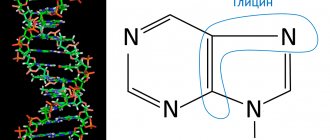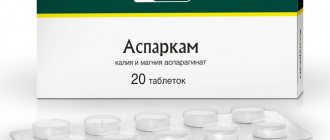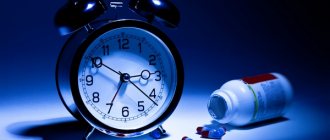What is glycine and what is its role in the body? Glycine is a non-essential amino acid that is involved in many vital processes and also helps to survive emergency situations. The key role of glycine is its direct participation in the process of energy formation in cells, protecting them from premature death and ensuring proper functioning. This is a unique substance with almost universal properties, which our body can produce on its own, but at the same time often experiences an increased need for it.
Pharmacological properties
Pharmacodynamics
As a regulator of metabolism, glycine helps to activate and normalize the processes of protective inhibition occurring in the central nervous system. The drug has glycinergic, GABAergic, α1-adrenergic blocking, antioxidant and antitoxic effects.
By regulating the activity of ionotropic glutamate receptors (NMDA), Glycine active reduces psycho-emotional tension, conflict, aggressiveness, increases social adaptation, improves mood, facilitates falling asleep and normalizes sleep, increases mental performance, reduces vegetative-vascular disorders (including during menopause), reduces the severity of brain disorders in traumatic brain injuries and ischemic stroke, suppresses the toxic effect of alcohol and drugs that can inhibit the function of the central nervous system.
Pharmacokinetics
Glycine has the ability to easily penetrate biological fluids and body tissues, including the brain. During the metabolism of the substance, water and carbon dioxide are formed; accumulation in tissues does not occur.
When should you increase your Glycine dose?
The drug should be taken according to the instructions, that is, no more than 3 tablets (300 mg) per day. The use of a large dose of the drug at one time (10 tablets or 1000 mg) is due to ischemic stroke or situations close to it.
If the goal of taking Glycine is to improve performance and mood, protect against central nervous system overload, prevent various diseases and maintain the desired level of amino acid in the body, there is no need to increase the dosage.
Remember that to achieve a therapeutic effect, it is important how to take Glycine, and not how many times a day. Glycine is applied sublingually or buccally. It is this taking of the drug that will provide the desired effect. If you just take the pills orally, there will be no harm, but there will be no positive effect either.
Indications for use
- organic and functional diseases of the nervous system, accompanied by emotional instability, increased excitability, sleep disturbance and decreased mental performance (neurotic disorders, neurosis-like conditions, consequences of traumatic brain injuries and neuroinfections, vegetative-vascular dystonia, various forms of organic brain lesions, including perinatal and alcoholic origin);
- reduced mental performance;
- psycho-emotional stress (including conflict and various stressful situations, exams);
- ischemic stroke;
- deviant behavior of children and adolescents.
Dosage and features of taking the drug
There is no clear answer to how many Glycine tablets you can take per day. The course and dosage depend on individual needs and taking into account the above factors. However, there are developed recommendations specified in the instructions that must be followed.
For sleep disturbances (frequent awakenings, difficulty falling asleep, etc.), prescribe ½–1 tablet 20 minutes before going to bed, or immediately before bedtime.
To improve concentration and memory, in case of mental stress, stress leading to psycho-emotional tension, a course is prescribed for 2-4 weeks with a dosage of the drug 2-3 times a day, 1 tablet. Similarly, the drug is given to children and adolescents to correct social deviation and mental retardation.
If there is a risk of ischemic stroke, adults can simultaneously take 10 Glycine tablets sublingually, and if a stroke is suspected, crushed and slightly diluted with water.
In the presence of lesions of the central nervous system of various types, which are accompanied by mood swings, excessive excitability, insomnia, etc., the course is 1–2 weeks. Tablets are taken 1 pc. 2–3 times daily. A repeat course is carried out after a month, if necessary.
In narcology, the drug is used as a means to help reduce stress and improve mental performance. For encephalopathy and PNS, a course is prescribed for 2–4 weeks with 1 tablet. 2–3 times a day. The drug is repeated 4–6 times a year.
The information provided on how many Glycine tablets can be taken per day is intended for children over 3 years of age, adolescents, and adults. For infants and children under 3 years of age, the dosage is reduced. For damage to the central nervous system, excessive excitability, and sleep disorders, it is prescribed to give ¼–½ tablet. 2–3 times a day. The duration of the course is 1–2 weeks, then the tablets are given in ½ pcs. daily for 7–10 days.
Reviews about Glycine active
From reviews of Glycine Asset it follows that the dietary supplement is in demand among various segments of the population. It not only has a calming effect, but also improves cerebral circulation, and therefore alertness and memory. Glycine quickly relieves nervousness and stress. The product is often used by students and students before exams, as well as older people with sleep disorders and an unstable psycho-emotional state.
Users note that Glycine asset has no side effects and is available to everyone at its own cost.
Reception features
What factors determine how much Glycine you can take per day?
- Age
. The drug can be given even to infants and taken in old age, so the dosage changes taking this factor into account. - What is the drug used for
? How much Glycine you need per day depends on the reasons for use. For example, to improve sleep, half or one tablet is enough, but for a stroke, 10 tablets with a small amount of water are used at once. - Individual appointment
. Consultation with your doctor will help you adjust your dosage regimen and the number of tablets for daily use to achieve maximum effect.
Biological role of glycine
Glycine is an inhibitory transmitter that, when overexcited, protects the nervous system from overload, providing protective inhibition. It has a calming property, but does not depress, but stimulates metabolic processes in neurons, as it stimulates cellular respiration. Therefore, after taking glycine as an anti-stress drug, there is no drowsiness or decreased cognitive function.
Glycine is an integral part of the mitochondrial respiratory chain, the Krebs cycle. During cellular respiration, glycine molecules are able to enhance the activity of oxidative reactions, increasing the efficiency of resource use to produce ATP. In case of intoxication, stress, or dysfunction of external respiration and blood circulation, the function of cellular respiration is disrupted, the cell suffers from a lack of ATP, which can lead to its death if problems with cell respiration are not resolved. Glycine helps solve the problem by restoring the activity of the Krebs cycle.
When is Glycine indicated?
Glycine is a neurotransmitter. It is actively prescribed for excessive mental stress, deterioration of memory, attention, and decreased performance.
The medication can be used for preventive purposes to improve cognitive functions in people under the age of 60. The course of prophylaxis can last up to 1 month.
The drug is indicated for increased aggression, excitability, and psycho-emotional stress. The medicine relieves the symptoms of these conditions by normalizing inhibitory mechanisms in the brain.
The medication is prescribed for autonomic dysfunction, including the onset of menopause. The drug is actively used for the treatment of ischemic stroke. While taking the medication, brain activity is restored faster.
Other indications:
- head injuries (concussions, skull fractures);
- dementia developing due to alcohol and drug abuse; relieving symptoms of alcohol intoxication;
- consequences of brain hypoxia in children (due to oxygen starvation in the womb or during childbirth);
- behavioral disorders in children and adults;
- mental retardation in a child.
It is acceptable to use the medication as an adjuvant therapy for myocardial infarction and angina attacks. The drug should only be prescribed by a doctor after a complete examination.
Sources
- N.Yu. Frolova, A.V. Buryakina, T.I. Melnikova // Neuroprotectors in pediatric practice // Pharmaceutical market // 2016
- M. V. Putilina // Modern ideas about nootropic drugs // Journal “Attending Physician” // 2006
- O.V. Grigorova, L.V. Romasenko, A.Z. Faizulloev, T.I. Vazagaeva, L.N. Maksimova, Ya.R. Narcissov // Use of Glycine in the treatment of patients suffering from adaptation disorder // Practical medicine // 2012
- M.R. Chuiko, N.M. Efremova, V.I. Skvortsova // Efficacy and safety of the use of glycine and limontar in the complex therapy of dyscirculatory encephalopathy and encephalopathy in insulin-dependent diabetes mellitus // Journal of Neurology and Psychiatry // 2010.
The effect of the drug Glycine
Why do children need glycine?
The high metabolic rate in the nervous tissue in children is due to constant growth and development, so the need for glycine is also high. Also, with the help of the amino acid glycine, imperfections in the mechanisms of excitation and inhibition can be mitigated, as a result of which the child’s adaptation to biological and psychological factors improves.
A child’s need for glycine often cannot be met by the body’s own resources, so pediatricians prescribe it in the form of a drug. As in adults, Glycine in this case is a signaling molecule that activates the synthesis of its own amino acid. Glycine can help with a variety of childhood problems - night terrors, neuroses, poor adaptation to kindergarten and school, lack of self-confidence, poor performance, ADHD. Since this is a natural substance for the body, it can be taken for a long time without fear of side effects and overdose.
Is it possible to have glycine for diabetes?
In diabetes, encephalopathy may develop due to vascular damage. Patients develop dementia over time. To delay brain destruction and prevent hypoxic conditions, use the drug Glycine. It is drunk in a dosage of 0.1 g three times a day. During therapy, mental abilities improve. Glycine in a standard small dose does not affect glycemic levels. According to studies, changes in glycemia are observed only with a dosage of 5 g per day or more. Since the use of very high dosages of the amino acid is impractical, this possible effect of the drug is not taken into account during treatment.
Transbuccally - how is that?
The characteristics of the glycine molecule determine the easiest way for it to penetrate into the blood - through the mucous membrane of the mouth.
In the instructions for use, you may find the words “sublingual” or “buccal”. What “sublingual” means can be understood simply by the sound of the word - the tablet must be placed under the tongue and kept there until completely dissolved, without dissolving.
Buccal administration is the placement of a tablet or powder behind the cheek, between the cheek and gum, usually in the area of the angle of the lower jaw. Buccal administration is especially convenient for young children, children with developmental delays, neurological patients, during and after a stroke, when keeping the medicine under the tongue is problematic.
How should adults take glycine?
In stressful situations, emotional overload, sleep disorders, neurotic reactions, autonomic dysfunction, it is recommended to take 1-2 tablets of glycine 3 times a day. To prevent insomnia and as maintenance therapy, 1 glycine tablet at night, 20-30 minutes before bedtime, is usually sufficient. For persistent cognitive disorders and organic brain lesions, the treatment regimen can be changed by your doctor at his discretion.
Narcologists prescribe Glycine to improve the emotional background and attitude towards treatment, restore metabolism, and reduce the severity of cognitive impairment. Usually the drug is prescribed as part of a complex treatment, 4-6 tablets per day, in courses of 30 days or more, with breaks of 14-30 days.
With the development of ischemic stroke, glycine can significantly reduce the affected area, or even prevent necrosis of brain tissue. To do this, within 3-5 hours from the development of ischemia, take 10 tablets (1 g) of Glycine - this can be done even before the ambulance arrives. The first thing to do when signs of a stroke appear is to call a doctor! Recovery after a stroke when taking Glycine proceeds faster and with better results; its use is advisable in any period after a cerebral accident, but is always more effective when started early.






